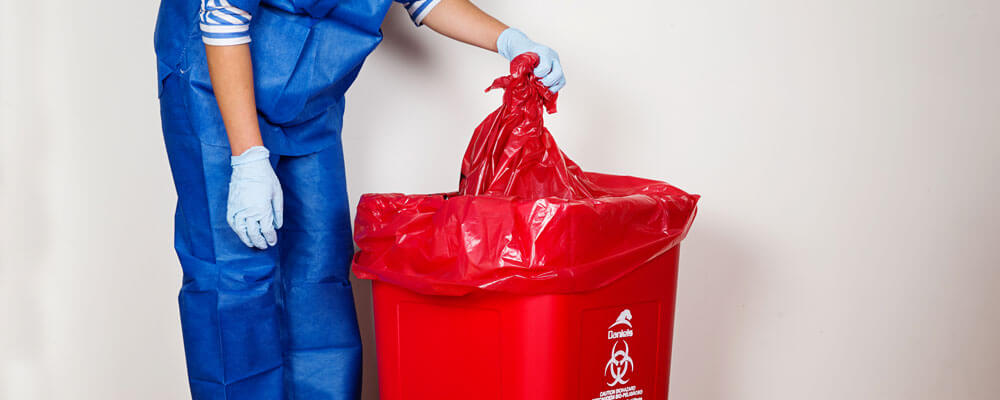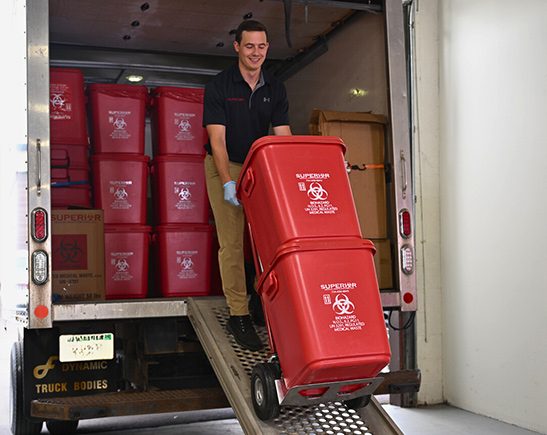Medical Waste Removal Quality: Elevating Safety And Security Requirements in Your Center
Medical Waste Removal Quality: Elevating Safety And Security Requirements in Your Center
Blog Article
Minimize Expenses and Maximize Security: Effective Medical Waste Disposal Methods
Efficient clinical waste disposal methods are vital for healthcare facilities to take full advantage of and reduce prices safety. By executing appropriate segregation and categorization, efficient product packaging and labeling, safe transportation and handling, reliable therapy and disposal methods, and compliance with regulatory guidelines, healthcare centers can ensure the liable and secure administration of clinical waste.

Appropriate Segregation and Categorization
Appropriate partition and categorization are crucial elements of effective medical garbage disposal methods, making certain the safety of health care workers, the public, and the atmosphere - medical waste removal services. medical waste disposal services with WasteX. By separating various sorts of medical waste at the factor of generation, healthcare centers can decrease the threat of cross-contamination and possible harm to people and communities
Among the vital variables in proper partition is the recognition and category of medical waste. This includes classifying waste right into various teams, such as transmittable, unsafe, radioactive, or pharmaceutical waste. Each classification requires particular handling, storage space, and disposal techniques to avoid any unfavorable effects on human wellness and the atmosphere.
Furthermore, appropriate partition additionally includes the usage of color-coded tags and containers to clearly recognize and separate the various sorts of medical waste. This aids health care workers and waste administration personnel to easily acknowledge and manage the waste appropriately. Red containers might be utilized for transmittable waste, while yellow containers might be marked for harmful waste.
Along with partition, appropriate categorization likewise entails the right product packaging and containment of medical waste. This makes sure that waste is firmly saved and moved without posturing any kind of risks to people or the setting. Using watertight and puncture-resistant containers, as well as effectively securing and classifying them, helps to avoid any kind of accidental exposure or release of dangerous materials.
Effective Packaging and Labeling
Effective packaging and labeling play a vital function in making certain the efficient and safe disposal of clinical waste. Appropriate packaging is important to stop leak, damage, or splilling throughout transport and handling. It assists to lessen the risk of contamination and protects health care workers, waste monitoring employees, and the environment from prospective risks.
Clinical waste must be packaged in tough and leak-proof containers that are resistant to puncture and damage. These containers must be appropriately secured to stop any leak. Furthermore, the packaging should have the ability to hold up against the conditions of transportation, including temperature level variations and rough handling.
Classifying is similarly crucial as it gives vital information regarding the components of the waste and any possible dangers associated with it. The labels need to consist of the name of the healthcare center, the kind of waste, and any special delivery instructions. Standard and clear labeling ensures that waste administration employees can quickly determine and manage the waste suitably.
Effective product packaging and labeling also aid in the correct segregation and classification of clinical waste. Clear labeling enables easy recognition of various waste streams, such as contagious waste, sharps, or pharmaceutical waste. This assists in simplifying the disposal process and ensuring that the waste is treated or taken care of according to governing guidelines.
Safe Transport and Handling
Making sure the safe transport and handling of clinical waste is of utmost importance in order to stop any type of prospective wellness and environmental threats. Medical waste, such as sharps, infected products, and pharmaceutical waste, must be effectively packaged and dealt with to reduce the risk of direct exposure to dangerous substances and pathogens.
Transferring medical waste requires compliance with rigorous regulations and guidelines established by ecological companies and local authorities. These guidelines intend to secure the health and wellness of employees entailed in waste management and stop the launch of harmful materials right into the environment.
To make sure safe transport, medical waste should be positioned in puncture-resistant and leak-proof containers that are appropriately secured and labeled. These containers ought to be protected in such a way that prevents spills or breakage throughout transportation (medical waste removal). Furthermore, it is essential to use customized cars geared up with suitable safety attributes to transport clinical waste. These automobiles ought to have appropriate ventilation and be developed to stop leakage or contamination.
Handling medical waste additionally requires appropriate training and adherence to security protocols. Employees associated with the handling of clinical waste must put on proper individual protective equipment (PPE) such as dress, masks, and handwear covers to minimize the threat of exposure. They ought to additionally adhere to strict hygiene go to my blog techniques to avoid the spread of infections and ensure the secure disposal of waste.
Effective Treatment and Disposal Methods
Applying appropriate treatment and disposal approaches is critical in handling medical waste efficiently and reducing possible health and wellness and environmental dangers. Medical waste, which consists of sharps, contagious products, useful reference chemicals, and drugs, can pose substantial hazards otherwise managed and gotten rid of correctly. There are numerous therapy and disposal techniques offered that stick to governing standards and promote secure methods.
One common method is incineration, which entails burning the waste at heats. Incineration works in destroying microorganisms and minimizing the volume of waste, however it can launch unsafe toxins into the air otherwise properly managed. It is vital to use modern-day incinerators outfitted with exhaust control technologies.
An additional technique is autoclaving, which uses steam and pressure to disinfect the waste. Autoclaving is reliable in eliminating virus and decreasing the volume of waste, yet it needs mindful tracking and maintenance to ensure proper performance. The sanitized waste can after that be securely disposed of in a garbage dump.
Chemical therapy is another choice, which includes making use of anti-bacterials or other chemicals to counteract virus. This method is generally utilized for liquid waste, such as laboratory samplings. However, it is essential to make use of appropriate chemicals and adhere to proper treatments to make certain reliable treatment and stop environmental contamination.

Compliance With Regulatory Guidelines
Following regulative guidelines is essential in making certain correct compliance with medical garbage disposal methods. These standards are implemented to shield public health and wellness, protect against ecological contamination, and maintain office safety and security. Compliance with regulatory standards is important for health care facilities, as non-compliance can result in charges, fines, and reputational damages.
Governing standards detail the proper handling, storage space, transportation, and disposal of medical waste. They give details directions on packaging requirements, medical waste disposal services with WasteX labeling, and record-keeping. These standards likewise attend to the segregation of different waste streams, such as sharps, infectious waste, and pharmaceutical waste. Healthcare centers should guarantee that their waste monitoring techniques straighten with these guidelines to minimize the risk of direct exposure to hazardous materials and avoid the spread of infections.
To preserve conformity, healthcare facilities should develop detailed waste monitoring programs that consist of staff training, regular audits, and recurring tracking. It is important to maintain up-to-date with any type of modifications or updates to governing standards, as techniques might evolve with time. By remaining informed and carrying out correct methods, health care centers can lower the potential for regulative infractions and shield the health and wellness of their personnel, patients, and the surrounding community.
Verdict
To conclude, implementing reliable medical waste disposal methods is important for making best use of and lessening costs safety and security. Correct segregation and classification, efficient packaging and labeling, secure transportation and handling, and efficient treatment and disposal techniques are crucial actions to make certain compliance with regulatory guidelines. medical waste removal. By sticking to these techniques, healthcare centers can safeguard the environment and public health and wellness while additionally decreasing monetary problems related to medical waste management
By carrying out correct partition and categorization, effective product packaging and labeling, secure transportation and handling, efficient treatment and disposal approaches, and compliance with regulative guidelines, health care facilities can make sure the liable and secure monitoring of clinical waste. Red containers might be used for infectious waste, while yellow containers might be designated for hazardous waste.
Standard and clear labeling makes sure that waste administration personnel can easily recognize and take care of the waste properly. (medical waste disposal services with WasteX)
Clear labeling allows for simple identification of various waste streams, such as transmittable waste, sharps, or pharmaceutical waste. These guidelines additionally resolve the segregation of various waste streams, such as sharps, infectious waste, and pharmaceutical waste.
Report this page